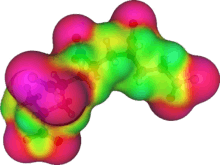COSMO Solvation Model

COSMO is the abbreviation for "COnductor-like Screening MOdel", a calculation method for determining the electrostatic interaction of a molecule with a solvent.
In COSMO the solvent is treated as a continuum with a permittivity ε, and therefore belongs to the "continuum solvation" group of models. As in all these models COSMO approximates the solvent by a dielectric continuum, surrounding the solute molecules outside of a molecular cavity. The details of the cavity construction differ in different COSMO implementations. In most cases it is constructed as an assembly of atom-centered spheres with radii approximately 20% larger than the Van der Waals radius. For the actual calculation the cavity surface is approximated by segments, e.g., hexagons, pentagons, or triangles.
Unlike other continuum solvation models, COSMO derives the polarization charges of the continuum, caused by the polarity of the solute, from a scaled-conductor approximation. If the solvent were an ideal conductor the electric potential on the cavity surface must disappear. If the distribution of the electric charge in the molecule is known, e.g. from quantum chemistry, then it is possible to calculate the charge q* on the surface segments. For solvents with finite dielectric constant this charge q is lower by approximately a factor ƒ(ε):
The factor ƒ(ε) is approximately[1]
where the value of x is set to 0.5 based on theoretical arguments. Some re-implementations of COSMO use x = 0.
From the thus determined solvent charges q and the known charge distribution of the molecule, the energy of the interaction between the solvent and the solute molecule can be calculated.
The COSMO method can be used for all methods in theoretical chemistry where the charge distribution of a molecule can be determined, for example semiempirical calculations, Hartree–Fock-method calculations or density functional theory (quantum physics) calculations.[2]
Comparison with other methods
While models based on the multipole expansion of the charge distribution of a molecule are limited to small, quasi-spherical or ellipsoidal molecules, the COSMO method has the advantage that it can be applied to large and irregularly formed molecular structures.
The COSMO method is more accurate for solvents with a higher permittivity because a solvent with infinite permittivity behaves like an ideal conductor. With water (ε ≈ 80) a very good accuracy is achieved. Nevertheless, with the choice of x = 0.5 even at low permittivities it is almost as accurate as a complete solution of the electrostatic equations, though at much lower numerical costs. Apart from the numerical effciciency, another big advantage of COSMO compared to other dielectric continuum methods is its huge reduction of the artifacts caused by the small part of the electron density reaching outside of the cavity, the so-called outlying charge errors. For more information in comparison, Q-Chem. "11.2 Chemical Solvent Models". Q-Chem 4.3 User’s Manual. by Q-Chem.inc.
See also
References
- ↑ Q-Chem. "11.2 Chemical Solvent Models". Q-Chem 4.3 User’s Manual. Q-Chem.inc.
- ↑ A., Klamt; G., Schüürmann (1993). "COSMO: a new approach to dielectric screening in solvents with explicit expressions for the screening energy and its gradient". J. Chem. Soc. Perkin Trans.2. 2 (5): 799–805. doi:10.1039/P29930000799. Retrieved 25 October 2015.
Further reading
- A. Klamt, G. Schüürmann (1993). "COSMO: A new approach to dielectric screening in solvents with explicit expressions for the screening energy and its gradient". Journal of the Chemical Society, Perkin Transactions 2: 799–805. doi:10.1039/P29930000799.